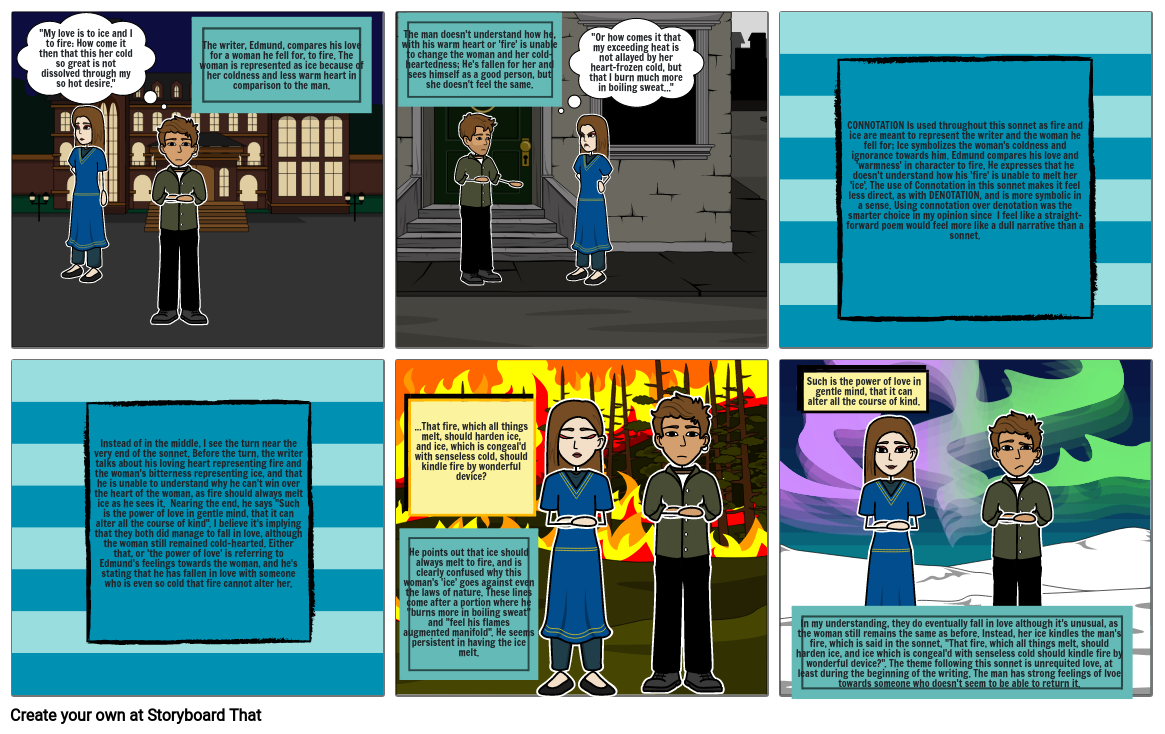Sonnet

Texto del Guión Gráfico
- "My love is to ice and I to fire: How come it then that this her cold so great is not dissolved through my so hot desire."
- The writer, Edmund, compares his love for a woman he fell for, to fire. The woman is represented as ice because of her coldness and less warm heart in comparison to the man.
- The man doesn't understand how he, with his warm heart or 'fire' is unable to change the woman and her cold-heartedness; He's fallen for her and sees himself as a good person, but she doesn't feel the same.
- "Or how comes it that my exceeding heat is not allayed by her heart-frozen cold, but that I burn much more in boiling sweat..."
- CONNOTATION Is used throughout this sonnet as fire and ice are meant to represent the writer and the woman he fell for; Ice symbolizes the woman's coldness and ignorance towards him. Edmund compares his love and 'warmness' in character to fire. He expresses that he doesn't understand how his 'fire' is unable to melt her 'ice'. The use of Connotation in this sonnet makes it feel less direct, as with DENOTATION, and is more symbolic in a sense. Using connotation over denotation was the smarter choice in my opinion since I feel like a straight-forward poem would feel more like a dull narrative than a sonnet.
- Instead of in the middle, I see the turn near the very end of the sonnet. Before the turn, the writer talks about his loving heart representing fire and the woman's bitterness representing ice, and that he is unable to understand why he can't win over the heart of the woman, as fire should always melt ice as he sees it. Nearing the end, he says "Such is the power of love in gentle mind, that it can alter all the course of kind". I believe it's implying that they both did manage to fall in love, although the woman still remained cold-hearted. Either that, or 'the power of love' is referring to Edmund's feelings towards the woman, and he's stating that he has fallen in love with someone who is even so cold that fire cannot alter her.
- He points out that ice should always melt to fire, and is clearly confused why this woman's 'ice' goes against even the laws of nature. These lines come after a portion where he "burns more in boiling sweat" and "feel his flames augmented manifold". He seems persistent in having the ice melt.
- ...That fire, which all things melt, should harden ice, and ice, which is congeal'd with senseless cold, should kindle fire by wonderful device?
- In my understanding, they do eventually fall in love although it's unusual, as the woman still remains the same as before. Instead, her ice kindles the man's fire, which is said in the sonnet, "That fire, which all things melt, should harden ice, and ice which is congeal'd with senseless cold should kindle fire by wonderful device?". The theme following this sonnet is unrequited love, at least during the beginning of the writing. The man has strong feelings of lvoe towards someone who doesn't seem to be able to return it.
- Such is the power of love in gentle mind, that it can alter all the course of kind.
Más de 30 millones de guiones gráficos creados

